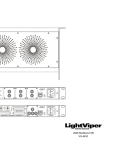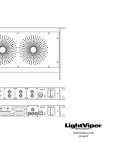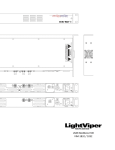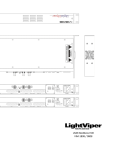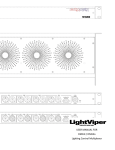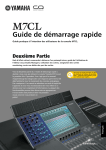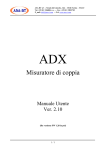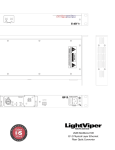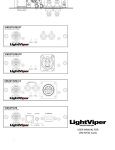Download USER MANUAL FOR VIS-1832/VIM-1832
Transcript
USER MANUAL FOR VIS-1832/VIM-1832 r061026 1 This page intentionally left blank 2 Important Safety Instructions ATTENTION: RISQUE DE CHOC ELECTRIQUE – NE PAS OUVRIR WARNING: TO REDUCE THE RISK OF ELECTRIC SHOCK DO NOT EXPOSE THIS EQUIPMENT TO RAIN OR MOISTURE The symbols shown above are internationally accepted symbols that warn of potential hazards with electrical products. The lightning flash with arrow point in an equilateral triangle means that there are dangerous voltages present within the unit. The exclamation point in an equilateral triangle indicates that it is necessary for the user to refer to the owner’s manual. These symbols warn that there are no user serviceable parts inside the unit. Do not open the unit. Do not attempt to service the unit yourself. Refer all servicing to qualified personnel. Opening the chassis for any reason will void the manufacturer’s warranty. Do not get the unit wet. If liquid is spilled on the unit, shut it off immediately and take it to a dealer for service. Disconnect the unit during storms to prevent damage. Marking and warning information is provided on the bottom of the apparatus case. 3 Warning for Your Protection 1. Read these instructions 2. Keep these instructions 3. Heed all warnings 4. Follow all instructions 5. Do not use this apparatus near water. 6. Clean only with a dry cloth. 7. Do not block any of the ventilation openings. Install in accordance with the manufacturer’s instructions. 8. Do not install near any heat sources such as radiators, heat registers, stoves, or other apparatus (including amplifiers) that produce heat. 9. Do not defeat the safety purpose of the polarized or grounding-type plug. A polarized plug has two blades with one wider than the other. A grounding type plug has two blades and a third grounding prong. The wide blade or the third prong are provided for your safety. If the provided plug does not fit into your outlet, consult an electrician for replacement of the obsolete outlet. 10. Protect the power cord from being walked on or pinched particularly at plugs, convenience receptacles, and the point where they exit from the apparatus. 11. Only use attachments/accessories specified by the manufacturer. 12. Use only with the cart, stand, tripod, bracket, or table specified by the manufacturer, or sold with the apparatus. When a cart is used, use caution when moving the cart/apparatus combination to avoid injury from tip-over. 13. Unplug this apparatus during lightning storms or when unused for long periods of time. 14. Refer all servicing to qualified service personnel. Servicing is required when the apparatus has been damaged in any way, such as power-supply cord or plug is damaged, liquid has been spilled or objects have fallen into the apparatus, the apparatus has been exposed to rain or moisture, does not operate normally, or has been dropped. The apparatus shall not be exposed to dripping or splashing. No objects filled with liquids, such as vases, shall be placed on the apparatus. “WARNING To reduce the risk of fire or electric shock, do not expose this apparatus to rain or moisture.” The apparatus shall be connected to a MAINS socket outlet with a protective earthing connection. MAINS DISCONNECT: The plug shall remain readily operable. For rack mount or installation where plug is not accessible, an all-pole mains switch with a contact separation of at least 3 mm in each pole shall be incorporated into the electrical installation of the rack or building. Replace fuse with same type and rating only. MULTIPLE-INPUT VOLTAGE: This equipment may require the use of a different line cord, attachment plug, or both, depending on the available power source at installation. Connect this equipment only to the power source indicated on the equipment rear panel. To reduce the risk of fire or electric shock, refer servicing to qualified service personnel or equivalent 4 General Installation Instructions Please consider besides these general instructions also any product-specific instructions in the “Installation” chapter of this manual. Unpacking Check the equipment for any transport damage. If the unit is mechanically damaged, if liquids have been spilled or if objects have fallen into the unit, it must not be connected to the AC power outlet, or it must be immediately disconnected by unplugging the power cable. Repair must only be performed by trained personnel in accordance with the applicable regulations. Installation Site Install the unit in a place where the following conditions are met: The temperature and the relative humidity of the environment must be within the specified limits during operation of the unit. Relevant values are the ones at the air inlets of the unit. Condensation must be avoided. If the unit is installed in a location with large variation of ambient temperature (e.g. in an OB-van), appropriate precautions must be taken before and after operation. Unobstructed air flow is essential for proper operation. Air vents of the unit are a functional part of the design and must not be blocked in any way during operation (e.g. by objects placed upon them, placement of the unit on a soft surface, or installation of the unit within a rack or piece of furniture). The unit must not be heated up by external sources of heat radiation (sunlight, spot lights). Ambient Temperature Units and systems by LightViper are generally designed for an ambient temperature range (i.e. temperature of the incoming air) of +5...+40 °C. When rack mounting the units, the following facts must be considered: The admissible ambient temperature range for operation of the semiconductor components is 0 °C to +70 °C (commercial temperature range for operation). The air flow through the installation must provide that the outgoing air is always cooler than 70 °C. Average heat increase of the cooling air shall be about 20 K, allowing for an additional maximum 10 K increase at the hot components. In order to dissipate 1 kW with this admissible average heat increase, an air flow of 2.65 m_/min is required. Example: A rack dissipating P = 800 W requires an air flow of 0.8 * 2.65 m_/min which corresponds to 2.12 m_/min. If the cooling function of the installation must be monitored (e.g. for fan failure or illumination with spot lamps), the outgoing air temperature must be measured directly above the modules at several places within 5 Earthing and Power Supply Earthing of units with mains supply (class I equipment) is performed via the protective earth (PE) conductor integrated in the mains cable. Units with battery operation (< 60 V, class III equipment) must be earthed separately. Earthing the unit is one of the measures for protection against electrical shock hazard (dangerous body currents). Hazardous voltage may not only be caused by defective power supply insulation, but may also be introduced by the connected audio or control cables. This equipment may require the use of a different line cord, attachment plug, or both, depending on the available power source at installation. If the attachment plug needs to be changed, refer servicing to qualified service personnel If your unit mains supply is provided via a Neutrik PowerCon™ connector the following precautions must be followed: The PowerCon must be installed and fully engaged before AC power is applied to the unit. The unit must be disconnected from the mains supply before disengaging the PowerCon connector. Class I Equipment (Mains Operation) Should the equipment be delivered without a matching mains cable, the latter has to be prepared by a trained person using the attached female plug (IEC320/C13 or IEC320/C19) with respect to the applicable regulations in your country. Before connecting the equipment to the AC power outlet, check that the local line voltage matches the equipment rating (voltage, frequency) within the admissible tolerance. The equipment fuses must be rated in accordance with the specifications on the equipment. Equipment supplied with a 3-pole appliance inlet (protection conforming to class I equipment) must be connected to a 3-pole AC power outlet so that the equipment cabinet is connected to the protective earth. WARNING If the ground is defeated, certain fault conditions in the unit or in the system to which it is connected can result in full line voltage between chassis and earth ground. Severe injury or death can then result if the chassis and earth ground are touched simultaneously. 6 Registration Be sure to register your LightViper product, either by filling in the enclosed Registration Card or by completing the on-line registration form at our Web site: http://lightviper.com/register.aspx If you do so, FiberPlex can contact you with any update information. As enhancements and upgrades are developed, you will be contacted at the registration address. Please read this manual - if you call for technical support, we’ll assume that you have. Please address any inquiries to your dealer or directly to FiberPlex at: FiberPlex Inc. 10840-412 Guilford Rd. Annapolis Junction, MD 20701 301.604.0100 Fax: 301.604.0773 [email protected] Limited Lifetime Warranty FiberPlex products are warranted against defects in material and workmanship for their lifetime. This warranty covers the original purchaser only and is not transferable. The lifetime of a product is defined as the period during which the product is manufactured, or can be repaired. FiberPlex will, at its discretion, repair or replace a defective product. FiberPlex warrants that its software and firmware, designed by FiberPlex for use with an instrument will execute its programming instructions when properly installed on that instrument. FiberPlex does not warrant that the operation of the instrument, the software, or the firmware will be uninterrupted or error free. FiberPlex’s products are not authorized for use as critical components in life support devices or systems without the express written approval of the president of FiberPlex, Inc. This warranty does not cover damage from acts of God, accident, abuse, neglect, contamination, unauthorized modification or misuse, operation outside of the environmental specifications for the product, improper site preparation or maintenance, or abnormal conditions of handling. This would include over-voltage failures, and conditions outside of the products specified ratings, problems with buyer-supplied software or interfacing, or normal wear and tear of mechanical components. To return a defective product, please contact our Sales Department for a Return Materials Authorization number (RMA), by calling 301-604-0100, or email: [email protected] Failure to properly package and protect the product during shipping may void this warranty. The RMA number must be written on the outside of the carton. We cannot accept delivery of any equipment that is sent to us without an RMA number. The Buyer shall prepay shipping charges to FiberPlex, and FiberPlex shall pay the return shipping charges. The remedies provided herein are the buyer’s sole and exclusive remedies. FiberPlex shall not be liable for any direct, indirect, special, incidental, or consequential damages. 7 Service The LightViper equipment contains no user-serviceable components: refer to qualified service personnel for repair or upgrade. Your warranty will be voided if you tamper with the internal components. If you have any questions with regard to the above, please contact FiberPlex. In the event your LightViper equipment needs to be upgraded or repaired, it is necessary to contact FiberPlex prior to shipping, and a Return Materials Authorization (RMA) number will be assigned. This number will serve as a reference for you and helps facilitate and expedite the return process. FiberPlex requires that shipments be pre-paid and insured —unless otherwise authorized in advance. IMPORTANT: ANY SHIPMENT THAT IS NOT PRE-PAID OR IS SENT WITHOUT AN RMA NUMBER WILL NOT BE ACCEPTED. Disposal Disposal of Packing Materials The packing materials have been selected with environmental and disposal issues in mind. All packing material can be recycled. Recycling packing saves raw materials and reduces the volume of waste. If you need to dispose of the transport packing materials, please try to use recyclable means. Disposal of Used Equipment Used equipment contains valuable raw materials as well as materials that must be disposed of professionally. Please return your used equipment via an authorized specialist dealer or via the public waste disposal system, ensuring any material that can be recycled is. Please take care that your used equipment cannot be abused. After having disconnected your used equipment from the mains supply, make sure that the mains connector and the mains cable are made useless. Declarations of Conformity Class A Equipment - FCC Notice This equipment has been tested and found to comply with the limits for a Class A digital device, pursuant to Part 15 of the FCC Rules. These limits are designed to provide a reasonable protection against harmful interference when the equipment is operated in a commercial environment. This equipment generates, uses, and can radiate radio frequency energy and, if not installed and used in accordance with the instruction manual, may cause harmful interference to radio communications. Operation of this equipment in a residential area is likely to cause harmful interference, in which case the user will be required to correct the interference at his own expense. Disclaimer The information in this document has been carefully checked and is believed to be accurate at the time of publication. However, no responsibility is taken by us for inaccuracies, errors, or omissions, nor is any liability assumed for any loss or damage resulting either directly or indirectly from use of the information contained within it. 8 35YD Introduction Congratulations on your purchase of a Light Viper 1832 fiber optic audio snake—a lightweight, flexible breakthrough for professional sound production. Light Viper products are designed, engineered and manufactured by FiberPlex, experts in fiber optics with decades of experience. Our work in audio and data communications products is known in US government applications worldwide. Light Viper products, combine our pioneering technology with the highest standards in audio engineering. The Light Viper You have purchased the LightViper 1832 system, a 32 x 8 Fiber Optic Transport System (FTS) that has the function, look and feel of a traditional copper snake; however instead of a heavy multi-conductor cable the Light Viper snake features a lightweight, flexible fiber built to “ruggedized” military standards. The Fiber Advantage Fiber optics offer many advantages over copper: • Transmits light rather than electrons • Transmission over greater distances (more than 11⁄4 mile) • Complete electrical isolation • Immunity to RFI and EMI • Eliminates ground loop problems • Can be routed overhead, through walls, or underground • Avoids foot traffic while maintaining aesthetics Functional Considerations Although the Light Viper 1832 looks essentially the same as a traditional, passive snake, it is an active device. Because of this, there are some aspects of this new technology that require some slightly different thinking: • The Light Viper 1832 requires AC Power at both the Stage Box and the Mixer Unit(s) • Phantom Power is delivered from the Stage Box, NOT the console • The snake has three selectable gain settings and a clip indicator at each input on the Stage Box • All inputs exit the snake (at the Mixer Box) at Line Level • DI boxes are not necessary in most cases • Input and Output flexibility may eliminate the need for some of your outboard gear • The LightViper VIM-1832 is an active device, therefore do not attempt to connect intercom into the returns • The returns in the VIS-1832 cannot be “turned around” to provide 40 sends one way as with a traditional copper snake, as the electronics for the returns are contained in the VIM-1832. 9 Standard Components In its standard configuration, the Light Viper 1832 is made up of the following primary components. • The Stage Box (VIS-1832) — This is the box placed close to all the inputs. It can be placed on the stage or rack mounted with the optional VER-1832 rack ears. • The Mixer Box (VIM-1832) — The unit should be mounted in a rack close to the primary (FOH) mixing console • The Fiber Cable (TFC-0000-04) — The lightweight “tactical grade” fiber ‘cable’ that carries the digital signal between the stage and mixer boxes. For installation use, either PVC or Plenum rated fiber is recommended (VFC-0000-D, VFC-0000-DP). • TAC-4 Connector Panels – (VPL-11, VPL-12, VPL-13) – These 1U rack panels contain (1), (2), or (3) panel mount TAC-4 connectors mounted respectively and allow connection between tactical grade fiber to the ST connectors on the VIM units. • Rack Ears – (VER-1832-T1, T2 or T3) These rack mount kits for the VIS-1832 have 1, 2 or 3 panel mount TAC-4 connectors mounted respectively and allow connection between tactical grade fiber to the ST connectors on the VIS units. See page 20 for more information. • Send / Return Cables (VCB-ADXM, VCB-ADXF) — These cables connect the Mixer Box to the analog inputs/outputs of your mixer. If you are connecting to a Yamaha digital console through the Yamaha “Y” cards, you would use VCB-DDMY and VCB-DDMYIO cables. A variety of cables to connect to other digital consoles and devices are also available. Optional Components Additional components can be added to the Light Viper 1832 for increased functionality. • Additional Send Box(es) (VIM-1032) – The VIM-1032 is similar to the VIM-1832 mixer box in that it provides a parallel set of the snake’s 32 input channels, via an additional Fiber Cable, in applications where you need splits – for recording, broadcast, or monitor mixing. The VIS1832 Stage Box can be fit with two “split” connectors for a total of three (1 VIM-1832 (Primary) + 2 VIM-1032 (splits) outputs. • Additional Analog Fan Out Cable(s) (VCB-ADXM / VCB-ADXF) – These fan out cables are necessary for connecting additional mixer boxes (VIS-1832 and VIS-1032) to your analog equipment. You need (4) VCB-ADXM for each VIM-1832 or VIM-1032 mixer boxes in the system. The VIM-1832 also requires (1) VCB-ADXF (female) fan out to access the returns. • Additional Digital Cables – To connect AES digital directly into a Yamaha PM5D, DM2000, DM 1000 or M7, you need (2) optional cables for each 32x8 system. (1) DDMY and (1) DDMYIO will allow a 32x8 connection into the Yamaha MY16AE cards. Optional cables are available to interface with Pro Tools and other types of devices and various connector configurations. • Ethernet Control – Add the optional ETH-1832 (pair) option to any Stage / FOH path, and control a variety of Ethernet based gear on stage from the FOH position. • Additional Fiber Cable(s) – For live production, TFC-0000-04 tactical grade fiber with TAC-4 Connector terminations is required between the stage box (VIS-1832) and all mixer boxes (VIS-1832 and VIS-1032). For installations where the fiber will be pulled through conduit, either VFC-0000-D (PVC fiber) or VFC-0000-DP (Plenum rated fiber) with ST connector terminations is recommended. There is also an option for a “Pulling Eye” which can be specified by adding an “E” to the part numbers above (VFC-0000-DE; VFC-0000-DPE). This option includes a strain relief and pulling eye on one end of the fiber optic cable. • Stage Box Mounting Hardware – The optional VER-1832 rack mount can be utilized in applications where the stagebox (VIS-1832) will be rack mounted. The VER-1832-T1, T2 and T3 rack mount kits include panel mount TAC-4 connectors in quantities of 1, 2, and 3 respectively. The rack ears can also be fit with Neutrik “OpticalCon” panel mount connectors. The part numbers are VER-1832-T1-OC, T2-OC, and T3-OC respectively. • TAC-4 and OpticalCon connectors can also be fit directly on the chassis of the VIS-1832, VIM1832 and VIM-1032, in applications such as these, rack ears and VPL panels are not required. 10 Getting Started Setting up, and using your Light Viper 1832 is a quick and simple process. Just follow these steps: 1. Place the Stage Box in a location central to the majority of your signal sources. Place the Mixer Box close enough to the mixer so that the send cables can reach the console’s inputs, connect AC power 2. Connect and run the Fiber between the two boxes, power up and check the Sync light on both units 3. Connect the inputs and returns to the stage box. (Be sure to select the appropriate Gain and Phantom Power settings) 4. Connect the fan out cables to the console (send & return on VIS-1832, send only on VIS-1032) 5. Turn on phantom power as necessary. 6. Starting with a gain setting of 0 dB, set the gain switch at the highest gain setting which the clip light either just flashes at the peaks or is off. 7. Start mixing. NOTE: the signal coming into the console will be line level. When the gain switches on the VIS1832 are properly set, the signal going into the console will be hot. Use line level inputs or engage input pads to achieve optimal signal-to-noise ratio. The more advanced functions of the Light Viper 1832 (control, clocks, etc.) are addressed later in this manual. 11 The Stage Box - VIS-1832 3 1 Input - Each of the 32 inputs on the Stage Box is a Neutrik, XLR/TRS combo connector. Each input has 3 switch-selectable gain settings: 0 dB, 26 dB, and 46 dB. All inputs accept balanced or unbalanced signals, eliminating the need for adapters and DI boxes. The Clip LED will flash at 3 dB below peak clipping. (+16 dBu). The XLR inputs of the VIS-1832 have an input impedance of 1.8KΩ while the TRS has an input impedance of 1.8KΩ. 2 Return - Each of the 8 returns are made via Neutrik, XLR, male connectors. Returns are all line-level. 3 Phantom Power - 48V Phantom Power is switch-selectable in groups of eight inputs (1-8, 9-16, 17-24, 25-32) When switched on, the Phantom Power LED for that group will glow green. The 1/4” inputs of the Neutrik Combo connectors on the VIS-1832 are normalled so that phantom power is disconnected on a channel by channel basis when a 1/4” jack is inserted. This allows you to use these connectors in a bank that has phantom power enabled without fear of putting phantom power on your 1/4” line. Phantom power on the console should be turned off for Light Viper connected inputs as this could cause distortion on the channel. 4 Sync - The Sync LED indicates the status of the fiber optic link between the Stage Box and the Mixer Box. It has three states:, SOLID RED indicates there is no optical link present, ALTERNATING GREEN AND RED means the unit is searching for sync, SOLID GREEN - indicates optical link is present, and OFF indicates no power. 5 Fiber Connections - Each Stage Box has one to three fiber connections. The one marked ‘Primary’ should always be connected to the Mixer Box (VIM-1832) as it provides clock for the entire system. Any other connections would be made to additional send boxes. Always be sure to use appropriate fiber and connectors. The LightViper 1832 system uses multimode fiber. Single mode optics are available for situations where single mode fiber may already be installed. 1 4 2 2 2 1 3 4 The gain settings correlate to output levels as follows: A setting of 0, an input signal of 0dBu will produce an output at the VIM1832 of 0dBu. A setting of 26, an input signal of -26dBu will produce an output at the VIM1832 of 0dBu. A setting of 46, an input signal of -46dBu will produce an output at the VIM1832 of 0dBu. Typical uses for each gain setting: 0 dB - Line level instruments/equipment (eg. Keyboards, CD player, etc) 26 dB - Condenser microphones, “hot” dynamic microphones. 46 dB - Low output condenser microphones, dynamic mics. 6 Control Circuits Connector - This RJ-45 jack provides (3) bidirectional CMOS or TTL data lines (up to 38.4 KHz from Stage to FOH and 2MHz from FOH to Stage) plus voltage and GND. THIS IS NOT AN ETHERNET CONNECTOR —CONNECTING AN ETHERNET DEVICE TO THIS CONNECTOR COULD DAMAGE THE DEVICE. The Pin-Outs for this connector are detailed in the Appendix. Most CMOS or TTL functions/equipment can be adapted to make use of this connector. 7 Power Connector - Power to the Stage Box is provided with the supplied Neutrik “Powercon” power cable. The internal power supply can accept 90-260V at either 50 or 60Hz. VIM-1832 and VIM-1032 units use standard IEC power cables. The supplied power cord will be appropriate to the country of delivery. 8 Fuse - The power fuse is a 5x20 mm, 1A Slo-Blo. Only replace the fuse with an exact match. If after replacement the fuse blows again, return the unit for service. 12 6 5 5 8 7 6 1 2 3 7 5 8 9 4 The Mixer Box – VIM-1832 1 Analog Sends - Exiting the Mixer Box, the sends from the Stage Box are grouped in 4 groups of 8. Each group is accessed via DB-25 to XLR “fan out” cables. DB-25 TO 1/4” cables are also available for use with mixers that only allow line level connection through 1/4” jacks. Each send exits the Mixer Box at Line Level, maximizing headroom on the console. 2 Analog Returns - The analog returns to the Stage box are made via a single DB-25 to XLR “fan out” cable. The DB-25 connectors on both the Analog Sends and Returns utilize standard DA-88, TASCAM balanced pinout configuration. Connector pin-outs are illustrated in the Appendix. 3 Return Select Switch - The 8 return channels are switch-selectable as EITHER analog OR digital. This selection is made via the recessed switch in the center of the Mixer Box adjacent to the clock connections. 4 Digital Returns - The digital returns to the Stage box are made via a single DB-25 to XLRF cable. These inputs MUST be used in conjunction with the Clock I/O described below in either master or slave mode. The DB-25 connectors on both the Digital Sends and Returns utilize a standard AES3 balanced pin-out configuration. Cable and connector pin-outs are illustrated in the Appendix. NOTE: The Analog DA-88 cables are not pin compatible with the digital cables. 5 Digital Sends - The sends from the stage box are simultaneously available as AES3 digital signals. Connections are made via 2 DB-25 connectors, with 16 channels on each. Access to the digital signal allows for connection to digital recorders or consoles, bypassing their onboard converters and eliminating the need for outboard converters. For digital connection straight into a Yamaha PM5D, DM2000, DM1000 or M7CL, the optional VCB-DDMY and VCB-DDMYIO cables connect directly to the Yamaha MY16AE cards. Cables are available to connect to Pro Tools, or other devices. 6 Clock I/O - By itself, the entire Light Viper system is internally frequency coherent. The VIM-1832 Mixer Box contains the clock master for the system, and the Stage Box and any other send units that are connected via the optical splits all sync to the clock provided by the master. The LightViper 1832 system runs natively at 24 bit/ 96k, but can also run at 24 bit / 48k with a 48k clock input to the “clock in” connector on the VIM-1832. The clock I/O is used when you need to synchronize with external equipment making the entire system frequency coherent. When using the digital returns the VIM MUST BE in either master or slave mode with the equipment providing the digital input. The system can operate in Slave Mode —In this mode clock is supplied via the “clock in” connector overriding the internal clock. The “clock outputs” are pass-throughs for the clock connected to the input. In Master Mode there is nothing connected to the input and external equipment is connected to the Clock Out, making the internal clock the master in the system. The LED next to the Clock In connector has three states to indicate Status. Off —No signal present on the Clock Input Red —Signal is present on the Clock Input but it is neither a valid Word Clock nor Super Clock Green —There is either a valid Word Clock or Super Clock signal on the Clock In 7 Fiber Connector - The Mixer Box can be fit with ST connectors, a single tactical grade TAC-4 connector, or a Neutrik OpticalCon connector. In live production use, it is recommended to fit the VIM1832 and VIM-1032 units with ST connectors, and utilize the VPL-11, 12 or 13 panels containing 1, 2, and 3, TAC-4 panel mount connectors respectively. These connectors have ST pigtails which connect with the mixer box ST connectors. Always be sure to use appropriate fiber and compatible connectors. 8 Control Circuits Connector - This RJ-45 jack provides (3) bidirection (mixer box to stage box) CMOS or TTL data lines (up to 38.4 KHz from Stage to FOH and 2MHz from FOH to Stage) plus voltage and GND. THIS IS NOT AN ETHERNET CONNECTOR – CONNECTING AN ETHERNET DEVICE TO THIS CONNECTOR COULD DAMAGE THE DEVICE. The Pin-Outs for this connector are detailed in the Appendix. Most CMOS or TTL functions/equipment can be adapted to make use of this connector. 9 Power Connector/Fuse - Power to the Mixer Box is provided with the supplied 3-Prong IEC Power Cord. The internal power supply can accept any voltage from 90-260 at either 50 or 60Hz. The power fuse is a 5x20mm, 1A Slo-Blo. Only replace the fuse with an exact match. If after replacement the fuse blows again, return the unit for service. The Clock input will accept either “Word Clock” (96 KHz / 48 kHz) or “Super Clock” (24.576 MHz / 12.288 MHz). Outputs are provided for both clock types. 13 Cables Fiber Cable - (TFC-0000-04) The Fiber Optic ‘cable’ is the centerpiece of the Light Viper system. Weighing 8.4 lbs. (12.6kg) for (300) feet, the cable carries all (40) signals between the stage box and the Mixer Box. Additional cables connect the Stage Box to up to two more send boxes (splits). Several connector options are available and the cable can be as long as 1.25 miles (2 Km). Send Cable - (VCB-ADXM) Four of these cables are needed to utilize the analog outputs. They are used to connect the Mixer Box to the analog inputs of the console. Each cable is (1) DB-25 to (8) XLR male. Should your system require it, the cable is also available with TRS connectors. The Pin-Outs for this connector are detailed in the Appendix. Digital cables are available for connection to the AES3 digital outputs. Return Cable - (VCB-ADXF) One of these cables is needed for each VIM-1832 in the system. It is used to connect the Mixer Box to the analog outputs (returns) of the console. Each cable is (1) DB25 connector to (8) XLR female. Should your system require it, the cable is also available with 1/4” connectors or male XLR connectors. The Pin-Outs for this connector are detailed in the Appendix. 14 Need Return Cable Image Using the Light Viper 1832 —Live Sound This image illustrates how the Light Viper might be used in a live sound situation. The system accommodates all the signal needs of the main PA, monitor mix and truck based recording. 15 Using the Light Viper 1832 —Fixed Installation This image illustrates how the Light Viper might be used in a fixed install situation. The thin, lightweight cable can be run without conduit through walls and over drop ceilings dramatically reducing install costs. 16 Using the Light Viper 1832 —Remote Recording This image illustrates how the Light Viper might be used in a remote recording situation. The system allows for cable runs you could never consider with analog copper wires. 17 LightViper Specifications • High quality Neutrik® connectors • Heavy gauge steel construction • Rack mount and wall panel options available • Optional lossless 3 way split of all 32 channels on stage end • Simultaneous analog / AES3 digital outputs on all 32 Channels • Extended range and flexibility means limitless routing options • 32 x 8 fiber optic snake • Cable runs over 1.25 miles with no loss • Rugged fiber cable smaller in diameter than standard mic cable • 24 bit / 96kHz sampling • 48 Volt Phantom power on every channel • Every channel accepts balanced or unbalanced connections... No need for DI’s 1. General Specifications Total Harmonic Distortion + Less than 0.01% 1 KHz @ +4 dBu Frequency Response ± 0.5 dB 20-20kHz @ +16 dBu Dynamic Range 102 dB Crosstalk 5 dB above noise floor Sampling Rate 24 bit / 96kHz or 24 bit / 48 kHz Latency 630 μs each direction Phantom Power +48 VDC is applied to balanced XLR inputs for powering condenser microphones via 6.8 KW current-limiting / isolation resistors. LED (green) indicates phantom power on per row of 8 sends. Operating Temp 0 to +50°C ambient temperature. Send Channel LED LED (red) flashes when input level reaches 3 dB below clipping. (+16 dBu) Sync LED LED (green) indicates optical link OK, LED (red) indicates problem with optical link, LED (off) indicates no power. AC Power Universal 90-250 VAC, 50/60 Hz, IEC connector with fuse (VIM-1832), Neutrik PowerCon with fuse (VIS-1832) Max Current Rating VIS-1832 0.463 mA @ 90V VIM-1832 / VIM-1032 0.473 mA @ 90V On / Off Control Date + MIDI RJ-45 connector for logic level control, CMOS or TTL at 2 MHz max per channel. Dimensions VIS-1832 12.5" L X 8.75" W X 4 H 1 Rack Unit X 6.5" Deep VIM-1832 / VIM-1032 VIS-1832 VIM-1832 / VIM-1032 300 ft Fiber Cable Weight 12 lbs 6.5 lbs 6 lbs *1-Hum & Noise are measured with an AES17 compliant filter at 20 kHz. Temperature condition @+10 - +25° C. 2.1 Input Characteristics S/N ref +0dBu Connection Gain Setting Voltage Gain*2 Sensitivity*3 Analog Sends 132*4 46 200 (46dB) 8.25 mVrms -78 dBu 0 0(0 dB) 1.65 Vrms -83 dBu 26 20 (26dB) 82.5 mVrms -83 dBu n/a 0(0 dB) 1.65 mVrms -83 dBu (VIS-1832) Overload Clipping +16 dBu +19 dBu +16 dBu +19 dBu Input Impedance XLR 1.8 K TRS 10 K Analog Returns 1-8 (VIM-1832) Digital Returns 1-8 2 K AES3 Digital *1–Hum & Noise are measured with an AES17 compliant filter at 20 kHz. Temperature condition @+10 - +25° C. *2–0dBu is referenced to 0.775Vrms. output of +4dBu (1.23V). *4-All XLR connectors are balanced, center Phone Jacks are balanced (T=+, R= -, S=GND) or unbalanced (T=+, R & S=GND) *3–Sensitivity is the lowest level that will produce an 2.2 Output Characteristics Connection Actual Source Impedance For Use With Nominal Analog Returns 1-8 (Stage Box)*1 150 600 Lines Nominal +4 dBu (1.23 V) Analog Sends 1-32 (Mixer End) 150 600 Lines +4 dBu (1.23 V) Digital Sends 1-32 (Mixer End) AES3 Digital Output Level*2 Max Before Clip +19 dBu (7 V) +19 dBu (7 V) Connector*1 Neutrik XLR-3-332 type DB-25, Tascam™ DA-88 pinout, 8 channels per connector DB-25, 16 channels per connector *1–All XLR connectors are balanced. *2–0 dBu is referenced to 0.775 Vrms. 2.3 Optical Characteristics Connector*1 Installation Tension Operating Tension Min Bend Radius Crush Resistance Weight Fiber-Optic Cable*2 400 lbs 130 lbs 3.7" 228 lb/in2 19 lbs / 1000' Attenuation Bandwidth Numerical Aperture System Optical Data Rate System Operating Distance 1 dB/Km @1300 nm 500 MHz/Km @ 1300 nm 0.275 122 Mbs 2 Km (1.25 mi) Optical Fiber*3 *1–TFOL Circular, Keyed, 7/8-20 UNEF. *2–Tactical, Dual Fiber, Single Jacket 0.230" Outer Diameter, Kevlar™ Strength Member *3–Graded Index, Multimode, Dual Window (850/1300nm) 18 Appendix ANALOG – DB25 Cable Pin Outs 1. 2. 3. 4. 5. 6. 7. 8. 9. 10. 11. 12. 13. Ch. 8 + Ch. 8 G Ch. 7 Ch. 6 + Ch. 6 G Ch. 5 Ch. 4 + Ch. 4 G Ch. 3 Ch. 2 + Ch. 2 G Ch. 1 Unused 14. 15. 16. 17. 18. 19. 20. 21. 22. 23. 24. 25. Ch. 8 Ch. 7 + Ch. 7 G Ch. 6 Ch. 5 + Ch. 5 G Ch. 4 Ch. 3 + Ch. 3 G Ch. 2 Ch. 1 + Ch. 1 G ANALOG Connector Pin Outs 1. 2. 3. 4. 5. 6. 7. 8. 9. 10. 11. 12. 13. Ch. 8 + Ch. 8 G Ch. 7 Ch. 6 + Ch. 6 G Ch. 5 Ch. 4 + Ch. 4 G Ch. 3 Ch. 2 + Ch. 2 G Ch. 1 Unused 14. 15. 16. 17. 18. 19. 20. 21. 22. 23. 24. 25. Ch. 8 Ch. 7 + Ch. 7 G Ch. 6 Ch. 5 + Ch. 5 G Ch. 4 Ch. 3 + Ch. 3 G Ch. 2 Ch. 1 + Ch. 1 G Digital Connector Pin Outs 1. 2. 3. 4. 5. 6. 7. 8. 9. 10. 11. 12. 13. Ch 1&2 + Ch. 3&4 + Ch 5&6 + Ch. 7&8 + Ch. 9&10 + Ch. 11&12 + Ch. 13&14 + Ch 15 & 16 + Unused Gnd. Unused Gnd. Gnd. 14. 15. 16. 17. 18. 19. 20. 21. 22. 23. 24. 25. Ch 1&2 Ch. 3&4 Ch. 5&6 Ch. 7&8 Ch. 9&10 Ch. 11&12 Ch. 13&14 Ch. 15&16 Gnd. Unused Gnd. Gnd. Digital Connector Pin Outs 1. 2. 3. 4. 5. 6. 7. 8. 9. 10. 11. 12. 13. Ch 1&2 + Ch. 3&4 + Ch 5&6 + Ch. 7&8 + Ch. 9&10 + Ch. 11&12 + Ch. 13&14 + Ch 15 & 16 + Unused Gnd. Unused Gnd. Gnd. 14. 15. 16. 17. 18. 19. 20. 21. 22. 23. 24. 25. Ch 1&2 Ch. 3&4 Ch. 5&6 Ch. 7&8 Ch. 9&10 Ch. 11&12 Ch. 13&14 Ch. 15&16 Gnd. Unused Gnd. Gnd. Control Circuits RJ-45 Pin Outs 1. 2. 3. 4. 5. 6. 7. 8. GND TX1 TX2 TX3 RX1 RX2 RX3 VCC +5VDC 19 VER-1832 Rack Ears Available rack mount kits for the VIS-1832 have 1, 2 or 3 panel mount TAC-4 connectors mounted respectively and allow connection between tactical grade fiber to the ST connectors on the VIS units. The illustration below is in the T-1 configuration. Fiber Connection Plates Each fiber connection on LightViper components can be configured with any of the plates in the diagram. The plates accommodate different fiber connector types either singly. Four different ST plates accommodate 1, 2, 3, or 4 ST connections. A blank plate should always be installed in an unused connection bay. TAC-4 Installation Instructions Due to the hermaphroditic nature of the TAC-4 connector, channels 1 & 4 and 2 & 3 are crossed by necessity. Therefore, pins 1 & 2 should always be connected to connectors marked TX and pins 3 & 4 should always be connected to pins marked RX. Pins 1 & 4 are always paired together and pins 2 & 3 will always be paired together. 20 VIM-1832 Dimensions VIS-1832 Dimensions 21 22






















